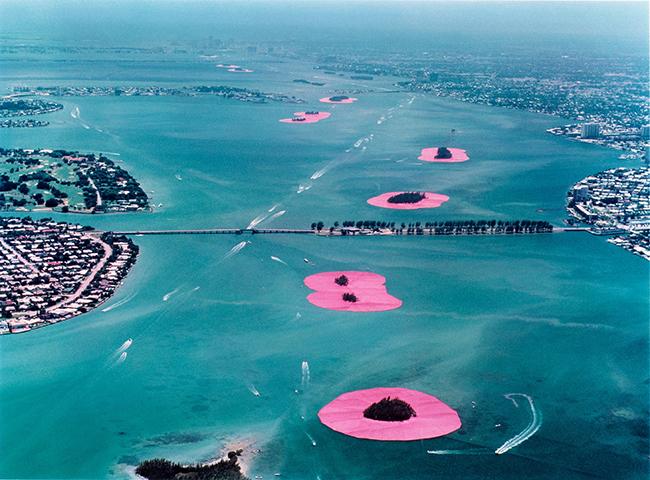Jeanne-Claude Denat de Guillebon and Christo Vladimirov Javacheff, better known as Christo, were born on the same day, June 13, 1925, within an hour of each other. She was born in Casablanca, Morocco and he in Gabrovo, Bulgaria. They met in 1958 when Christo was commissioned to paint the portrait of her mother. Married in Paris in 1959, they began a partnership that would become a world-wide sensation. Jeanne-Claude and Christo began creating art together in the 1960’s, but at that time women artists received little recognition for their work. The first international exhibition to recognize women artists opened on December 21, 1976. Jeanne-Claude was not among the 83 women artists recognized.
They began making art together in 1961. In their first adventure into outdoor environmental art, they used whatever they could find or afford. The process of wrapping of common objects used resin-soaked canvas, tied and coated with a mixture of glue, varnish, sand, and a thin layer of dark-black or brown lacquer. “Wrapped Jeanne-Claude” (1963) is an example of their early work. Wrapped furniture pieces were meant to be placed in the corner of a room.
Christo was listed as the sole artist of all their works until1994 when they announced that all the work had been created by Christo and Jeanne-Claude. They decided to list only Christo for marketing purposes because of the difficulty of establishing a reputation and generating a brand in the male dominated art world with its prejudice against female artists. The collaboration between them was so important to their art that they traveled separately on airplanes to insure that one of them could continue their work.
Christo would draw the ideas for each project. The creative process for the works, planning, decision making, and supervision, was a joint effort. In the project “Surround Islands” (1980-1983) (Biscayne Bay, Miami, Florida) eleven man-made, uninhabited islands used for dumping garbage were surrounded by 6.5 million square feet of floating woven pink polypropylene. The planning of the project started in 1981 with lawyers, marine engineers, consulting engineers, a building contractor, marine biologist, ornithologist, expert on mammals, US Army Corps of Engineers, and local government officials working with Jeanne-Claude and Christo to ensure the floating pink polypropylene could not and would not cause any damage to the environment. During the two-and-a half-year process, Jeanne-Claude and Christo had tests run to check that nothing they did would harm any living organism.
Jeanne-Claude and Christo set parameters for all of their work. The pieces interact with urban and natural landscapes. The areas are cleaned up before the works are created. When the project ends, the area must be returned to its original state, and all the materials must re-used for other purposes. However, the original site for “Surround Islands” was a garbage dump, and 40 tons of garbage, including car tires, boats, refrigerators, mattresses, and beer cans, were removed to clear the area for the project. In this case, the site was not restored to its original state.
Jeanne-Claude and Christo self-fund all their projects with proceeds of the sale of drawings, photographs, books, videos, and lectures by the artists. Their projects often take years to negotiate. The projects involve political negotiations, permits, approvals, hearings, and a lot of interaction with the public. They refuse to take grants, scholarships, or donations. “Surround Islands” required 430 workers. Although many would have been willing volunteers, all who worked on their projects were paid. In the case of “Surround Islands,” not only was the pink fiber sewed and placed by a group of workers that were assigned to each island, but also during the two weeks of the exhibition, boats cruised around the islands non-stop to ensure that no birds got trapped and that nothing else went wrong.
“Surround Islands” was a world-wide sensation. Renowned author, collector, and art critic Jacob Baal-Teshuva called the project “one of the most unforgettable and poetic sights art has produced in modern times.” An article published by the Orlando Sentinel on April 17, 1983, stated, “Pink used to mean flamingos, sunsets, and art deco hotels. Now it means Christo.” The duo stated they chose pink for “Surround Islands” because it is an artificial color, but pink is the color of the human hand.” The project became a huge tourist attraction bringing Miamians together in a new way, and it helped promote Miami as a thriving contemporary art scene.
For two weeks the world was shown the beauty of the project. The island skirts were magnificent. The color changed slightly as daylight transitioned into darkness. Thoughts of Monet’s waterlilies were expressed. Christo admitted that the driving force behind the project, its concept and execution, was Jeanne-Claude. Yet write-ups about the project omitted any mention of this fact. The woman’s role had to be hidden in order to get the permits.
“We make beautiful things, unbelievably useless, totally unnecessary.”
A final note: International Woman’s Day was celebrated on March 8, and March is International Woman’s Month. In 2022, there are still fewer woman represented in galleries and museums than men. Most articles continue to put Christo’s name first. However, all of the projects by the duo, now list them both as the artists. As an art historian, artist, and a feminist, this writer believes an article listing Jeanne-Claude first was necessary. It is a small but appropriate tribute to a woman whose importance, like that of many other women in the arts, needs to be given special attention.
Beverly Hall Smith was a professor of art history for 40 years. Since retiring with her husband Kurt to Chestertown six years ago, she has taught art history classes at WC-ALL and Chesapeake College’s Institute for Adult Learning. She is also an artist whose work is sometimes in exhibitions at Chestertown RiverArts and she paints sets for the Garfield Center for the Arts.








[…] Citation de la source: … […]